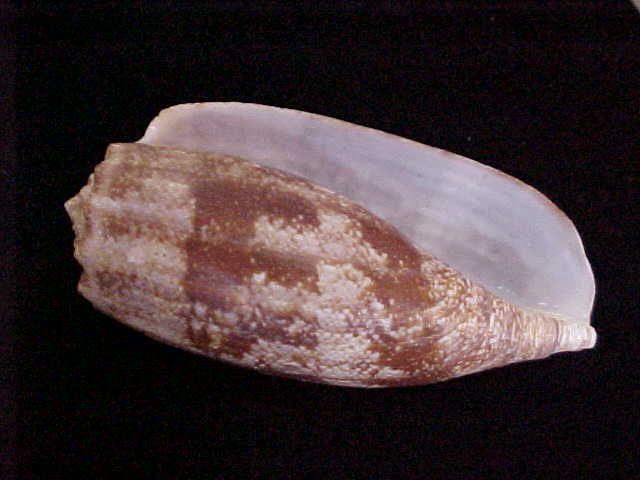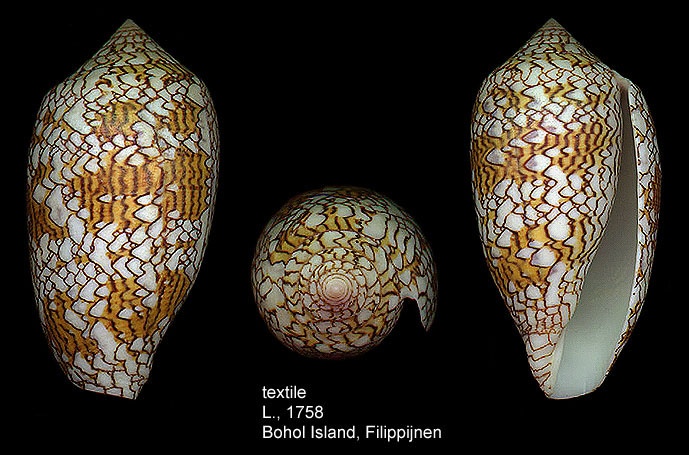|
As briefly related in the
previous Mollusc of the Moment, the animals which create the beautiful
and diverse Cone shells (and i'd like to note here that one must never
confuse shells, which are the "skeleton" of the animal, with
the animal itself: so often, even in reasonably scientific articles,
one will be presented with such inanities as "The Glory of the
Seas cone shell lives at moderate depths in the warm waters of the western
Pacific....." - just a pet peeve, but i think it important to bear
in mind that shells are carefully made by living organisms, and are
not like rocks or coins, which have no connection with life.), are hunters
by nature, and belong to a group ("superfamily" to be exact)
of molluscs which use hollow harpoon-like barbs to spear and inject
toxins into their prey, paralyzing them before they have a chance to
get a way. The other members of this group include the Terebras (Terebridae)
and the seemingly innumerable Turridae. These other families are not
harmful to humans, but some cone species most certainly are.
Conotoxins (the poisons which
cones use to paralyze their victims) are a fascinatingly diverse group
of relatively small proteins which affect the nervous system. The majority
are fast-acting toxins which paralyze the nerves of the animal in general,
while others are stimulants which cause muscles to cramp violently -
both methods being quite effective methods of stopping their prey in
their tracks. Normally, a mixture or "cocktail" of toxins
will be injected together, when any particular species attacks. There
are three basic groups of Cone species, based upon what they feed upon:
worms (vermivores), molluscs (mulluscovores) and fish (piscovores).
In mollusc-eating cones, several different injections containing different
mixtures of venoms are sequentially injected, while in the others, one
dart is usually all it takes, although for particularly feisty prey,
or for defense against a large animal such as a person, several "harpoons"
(technical name is radulae - the "teeth" of the mollusc) may
be used in quick succession. Many dozens of conotoxins are known, and
several kinds are being investigated as possible drugs, mainly for pain
killing or analgesic properties. A particular poison created by the
most variable cone in the world, shell-wise, Conus magus L., 1758 (Linneus
named most of the really common species, so his name pops up a LOT when
living things are mentioned. His goal was to describe all the species
in the world, and while he gave it a pretty good shot (anyone know how
many species he described in his lifetime?), he could of course only
scratch the surface of the estimated 100 million species our endangered
biosphere is though to contain (of which only 2 million or so have been
"discovered" and named so far...)), belonging to a group ominously
called the "Omega toxins", was thought quite promising as
a pain killer for a while, but recent tests have turned up some nasty
side effects which include things like unconsciousness - NOT a good
thing for a drug to induce in its victims!! The best Conotoxin site
on the web is Dr. Bruce Livett's Cone
Shells and Conotoxins storehouse of knowledge on the topic.
While many cone species can
deliver quite a nice "sting", the group amongst the cones
which contains members truly dangerous to humans is that of the piscovores,
or fish-eating cone-critters. Since fish are faster-moving and often
rather larger than the other groups' prey, the toxins used to paralyze
them quickly and effectively must be proportionately stronger. They
number about 70 species, but only a handful fall into the REALLY nasty
category, and only 3 have been known to kill people: the two featured
in this article, and Conus marmoreus - and yes this is another "Linnaean"
species!! Of the 30 or so known fatalities related to cones over the
years, the overwhelming majority have been caused by Conus geographicus
L., which is a large species, commonly attaining a size of over 100mm
(4 inches), and feeds upon pretty good-sized fishies - note the width
of its "aperture" (sometimes referred to as a "mouth").
It produces and is not at all hesitant in injecting an extremely powerful
"Conotoxin cocktail" which can kill a careless collector or
diver in 2 to 6 hours. Initially, a sharp, strong pain is felt, followed
by progressive paralysis, which if it reaches the heart, can kill.
Lest any of the gentle readers
(or even the not so gentle ones.... if any!!) develop a fear of going
in the water in tropical climes after reading the above "scary
stuff", i MUST emphasize that the danger presented by cones, although
real, is really pretty small. Cones do not live in places where they
could be stepped on easily, and most are completely nocturnal - coming
out to feed only at night (some Caribbean species are so light-phobic
that they can only easily be found on the darkest of nights when the
moon is less than a quarter full!). There is almost no danger of all
of accidentally being "stabbed" or stung by a cone snail,
so as the song says "don't worry be happy" in this regard.
THAT SAID, when collecting cones in Indo-Pacific waters (no dangerous
cones are known from the Atlantic Ocean), it is wise to wear thick gloves,
and even then to handle the beasts with care, since the larger ones
can pierce even wet suit gloves. While only a couple of species can
actually kill, being stung by a surprising number of species is no picnic:
the pain is reported to be quite fierce and can last up to 12 hours.
SO, "caveat collector" would be a smart motto for would-be
cone collectors!!
"For the record",
if you suspect someone has been stung by a cone, the best first aid
treatment is to have them lie down and be calm, restrict the flow of
blood from the sting with a pressure bandage (not a tourniquet - you
don't want to cause more harm than you are trying to prevent!), and
in the worst case, do CPR for as long as it takes to help the patient
through. Proper medical care should be sought in ANY case of suspected
poisoning on a beach - or anywhere else for that matter!
|
|
Conus textile Linne
(One can evoke Linnaeus' name in three commonly used ways - as a full-blooded
"Linnaeus", simply by the initial "L.", or by the
French version of his name: Linne, with a right-leaning accent over
the e, which i can't seem to figure out how to do on this keyboard.
The later is mainly used by botanists, since the science of botany was
extremely active in France in the decades following his pivotal work.
Linnaeus was in fact far more interested in "flora" than in
"fauna" at any rate, and besides being the "Father of
modern taxonomy", is most widely known and regarded as a botanist.)
is one of the most variable and most certainly the most common cone
species in the world. It can be found throughout the entire tropical
and subtropical regions of both the Indian and the Pacific oceans, and
lives in "weedy" sandy areas at shallow depths in huge numbers.
It displays an astounding variability, with almost two dozen widely-recognized
described forms and subspecies.
Conus geographics
L., also lives more or less throughout the Indo-Pacific, in a bit
deeper water than textile - so it is usually collected by divers willing
to take the risk of being stung by them: an unpleasant event even in
the great majority of cases, where nobody gets killed except perhaps
the mollusc. It is pretty easy to recognize, so i would say to all cone-collectors
to be "Don't try this at home", or anywhere else: this is
one species best simply left alone. It is easily and cheaply procured
from your friendly neighborhood shell dealer at any rate, so the risk
associated with this beastie is most DEFINITELY not worth it!!
|

